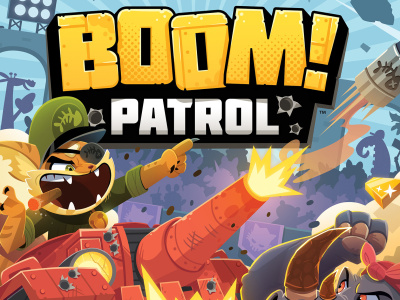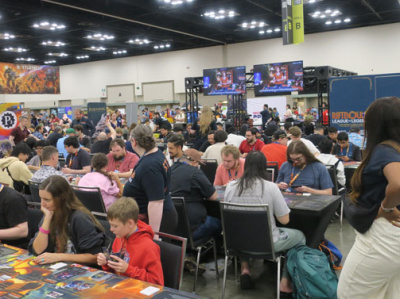 Get In The Game is a weekly column by Dan Yarrington, managing partner of Myriad Games in Manchester & Salem, New Hampshire, Treasurer of the Professional Game Store Association, and Editor-in-Chief of GameSalute.com. This week, Yarrington continues his discussion of the role of distribution in the hobby game industry.
Get In The Game is a weekly column by Dan Yarrington, managing partner of Myriad Games in Manchester & Salem, New Hampshire, Treasurer of the Professional Game Store Association, and Editor-in-Chief of GameSalute.com. This week, Yarrington continues his discussion of the role of distribution in the hobby game industry.Welcome back to Get In the Game, a column that focuses on proactive ways we can improve the games industry. This week, we continue the discussion started in our last installment (see “Get In The Game--Should Distribution Die?”) about the current state of distribution, whether the tier should exist at all, and what steps we can take to improve the systems currently in place. Thank you to everyone who sent in a Talk Back after the first part of this column ran last week. I’ve appreciated all the discussions and perspectives on this important topic.
Distributors provide access to a massive selection of product, much of which will be ordered in single copy quantities by a store, sold, and not reordered. There are simply too many titles to carry them all throughout the year, so many of these “one-and-done” items end up flitting across store shelves without establishing any continuing presence in the local market. Think about how that ephemeral stocking interacts with building up games in local communities. One person picks up the game this week and plays it in the store the following week. Someone else thinks “that seems cool” and goes to check out a copy, only to find that there is no copy to be checked out since it was a one-time order item. They don’t want to be bothered requesting it -- they weren’t that interested, but if it was in, they would have checked it out and possibly purchased it. From the store owner’s perspective, there was a wave of new releases that week, all for more established brands, that took up most of the ordering budget, along with all the new “one-and-done” items from that week. Or perhaps the singleton copies just fall off the ordering radar. And stores don’t need to carry the product, since they can rely on the just-in-time order fulfillment from their distributors when their customers request them, right? Maybe.
It’s all about the money. In this severely under-capitalized industry, built on shoestring budgets, no one wants to be caught holding the bag -- the bag being chock full of misfit games that no one wants to purchase. Distributors are the glue that holds the system together, by serving as a one-stop shop for most titles and the primary credit holders for most retail stores. At the same time, there are no significant benefits for early payment from stores to help mitigate that cash flow risk in the system. There’s no incentive to the stores that have money (who are most qualified for credit) to remit that money sooner than their terms allow. In many industries there are cash payment or pre-payment bonuses or credits. Not so in the games industry. Extra discount is awarded based on previous sales volume, but there is no financial consideration for regular recurring payments to a preferred vendor. There are also few incentives for committing to individual product lines more deeply, or for carrying a wider variety of titles. Changing that aspect alone could revolutionize distribution, allowing more of a value to be assigned to continuing featured presence on local shelves. This is especially true if there were inducements to support these behaviors in the form of savings based on preorder commitments or case quantity purchases.
Since we have distribution to rely on, stores of any size can exist and dabble in games, without having to fully commit to pushing titles in quantity or to expanding or enhancing the games selection. The barrier to entry is negligible, so the majority of stores prefer to play it safe and just order the proven best sellers, supplementing with special orders and additional items by request. As a result, the gulf between selection online vs. local stores widens, with local stores coming up short. As an industry, we do not have a reliable system in place to carefully evaluate titles in advance, choose the best games for our clientele, and then plug those games into our local game-buying community. We may hear good things about a game, but we don’t have any preorders or any incentive to order more than one, so we play it safe and purchase a single copy to “see how it does.” We sell most of these single copies of titles over the course of the year and reorder a select few when we get requests for them. How many of those titles are desired by local consumers without them taking the time to request them? And on the flip side, how many over-orders or reorders that don’t sell does it take to put a store or distributor out of business? Learning to manage that risk and be able to respond to customer demand in a timely fashion is essential to growing the industry.
Distributors should focus on refining and expanding their impressive array of inventory management services including warehousing, order processing, consolidated shipping and tracking, billing and credit management, and information systems.
Information systems need to be drastically upgraded to allow better management of inventory status changes (when something goes from ‘Available’ to ‘Temporarily Out of Stock’ for instance, or when something new is announced by a publisher). As soon as there’s information about a new title, it needs to be in the system, to start the evaluation process and begin building interest. Data is king. We need more good data in a timely fashion to answer the questions that will lead us to the best selection to match our customer base. What’s being played both locally, nationwide, and worldwide? What are customers looking forward to? What’s on their wish list to purchase? That sort of information could inform the creation of useful incentives to positively influence purchasing decisions. We need to get ahead of the market rather than trailing behind by two to three weeks. This sort of information could be consolidated by the distribution channel and help guide and expand purchases. All tiers of the industry need to work toward more efficient, complementary programs to manage these data points to help us all make smarter decisions.
There are some awesome sales reps in distribution. They need more time to get familiar with products and actively promote and sell the best matches for each store. Right now they’re so often buried in processing data and orders they just don’t have the time. As a customer of distributors, I want them to tell me what’s actually selling from week to week and month to month. Provide a concise summary of what’s new this week, next week, the week after, instead of email after email repeating the same information with half a dozen changes from the day before. Put it as a static page on their website, include only the new changes in your daily email, and link to the central page with updates.
So that’s the data, but how do we halt the game of hot potato that causes out of stock delays? Imagine a world with full print-run flooring arrangements for publishers. Distributors commit to handling their inventory so the publisher needs no warehouse, no shipping staff, no store fulfillment, no sales staff, etc. The distributors would provide all of that and serve as true service providers and partners with the publishers. Publishers can focus on publishing and distributors could focus on handling all the logistics, getting the product where it needs to be when it needs to be there. Out of stocks would drop drastically, we wouldn’t need to constantly ship things from the printer to the publisher’s warehouse, then on to the distributors warehouse in small dribs and drabs that each add more to the transfer cost for the product. Payments could be made to publishers for all product sold during a given month (or when total sold crosses a certain threshold) to allow adequate cash flow management.
So should distribution die?
No. Distribution is a vital part of the process of handling physical inventory and transferring it efficiently to the point of sale. The distribution system should expand and improve operations to better serve its customers, the publishers and stores. Without a serious re-working of how games are created, promoted, and distributed, the tabletop industry will never be able to realize its full potential.
So start working with your preferred distributors to improve their services to you. Provide feedback on product lines you’d like to see, services you’d like to have them offer, ways they can help you build sales, how they can improve your fill rates, how they can help coordinate and promote special events, and all the other myriad ways they can improve their services to you. You’re the customer -- tell the distributors what you want and back that up with your purchases. What are you waiting for? Get In The Game!
Please sound off with your thoughts -- Talk Back today!
The opinions expressed in this column are solely those of the writer, and do not necessarily reflect the views of the editorial staff of ICv2.com.







